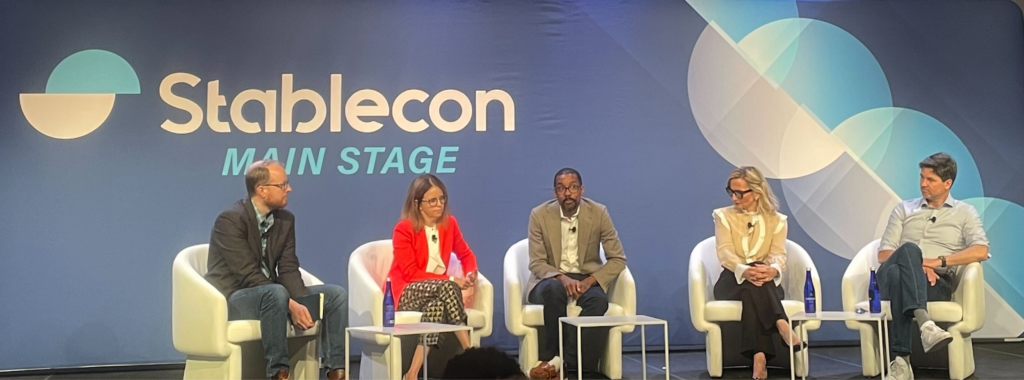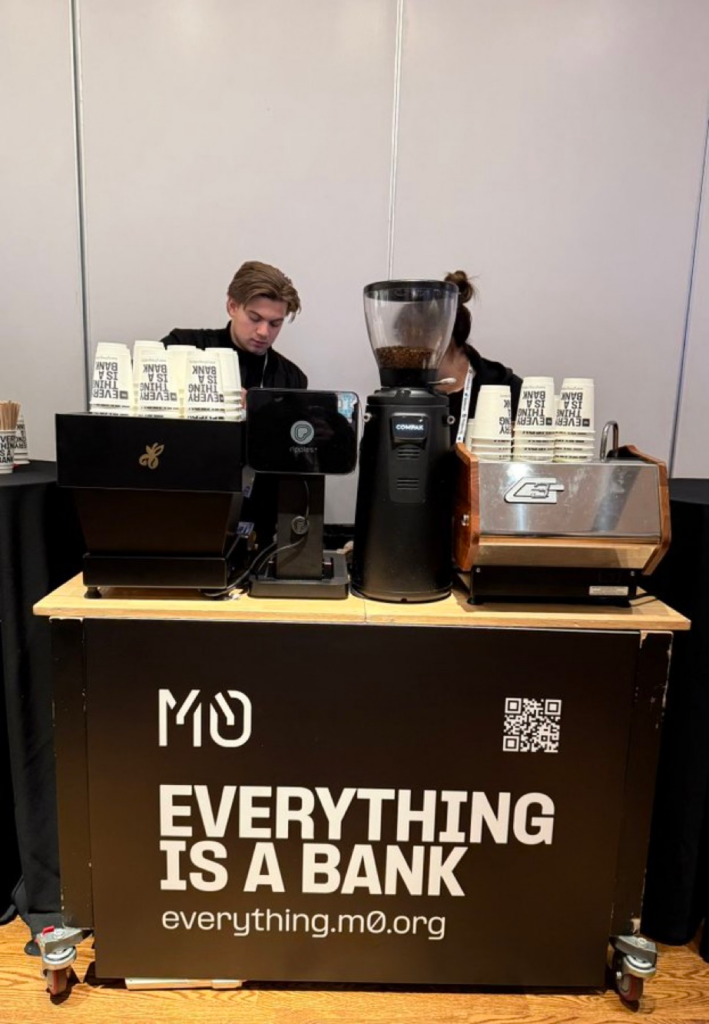I was delighted to get the opportunity this week to attend and speak at Stablecon, a stablecoin-focused conference put on by Nik Milanović and the team at This Week in Fintech in New York.

I moderated a session — The Shifting Regulatory Sands of Stablecoins — featuring an all-star group of panelists: Flavia Naves, Chris Brummer, Jelena McWilliams, and Mark Wetjen. I also (somewhat unusually) managed to attend a few other sessions at the event, so my notebook is full of random stablecoin musings.
I also managed to connect, in person, with quite a few fintech friends (old and new), which got my wheels spinning on a few non-stablecoin thoughts as well.
So, today, I’m just going to dump all my unorganized thoughts out and see if anything coherent appears.
Good Vibes Only
My first observation, after arriving at the conference, was that the vibes were very good. There’s apparently a Bitcoin conference happening in Las Vegas this week as well, so Stablecon attendees definitely skewed towards the boring side of the crypto continuum (that’s a compliment BTW! I didn’t hear anyone talking about tips for not getting hacked or kidnapped).
Still, there was a palpable sense of excitement and optimism. In fact, relatively few attendees actually attended the sessions (including mine). They mostly just hung out in the networking area and talked (loudly) the entire day.
A Rare Moment
There were quite a few regulatory and policy folks in attendance (including, obviously, my panelists), and a common talking point among them was how rare (and exciting) it is to get new financial services legislation at a federal level (especially when it’s not in reaction to a financial crisis).
The GENIUS Act has passed a key procedural step in the Senate and now appears to be on track for passage before the August recess. Reconciliation with the House bill and a signature from the President are virtually guaranteed to follow.
As such, the focus of policy folks and lobbyists is shifting from the legislation (which seems unlikely to change much from here) to the rulemaking work that will commence once the final bill is signed into law.
That rulemaking will require a significant amount of time and effort (although there is hope that it will proceed more quickly than what we saw after Dodd-Frank was passed in 2010). Crucially, the legislation leaves a lot of the technical details up to the regulators (not shocking … stablecoins are a complex topic, and the average congressional representative is quite old). The reason this matters is that it will be the first major financial services law enacted in a post-Loper Bright world, which has opened up regulation to more realistic legal challenges post-implementation.
The Stablecoin Community is Terrified of Bad Actors
Numerous speakers took time from the various stages at Stablecon to encourage (and, in some cases, beg) the builders in the audience not to abuse the trust that policymakers are placing in them, via the GENIUS Act.
There seemed to be a universal recognition that the fastest path back to a more universal anti-crypto attitude among regulators and legislators is for a company in the stablecoin space to screw up in a way that negatively impacts end customers and undermines the perception of safety that has started to settle around stablecoins.
They all basically said, “We can’t have another FTX or Synapse.”
As it relates to stablecoins, specifically, there were a few areas that were flagged as potential concerns, including: reserves (If it’s not 100% backed by cash or treasuries, it’s not a stablecoin), BSA/AML (I personally think this is going to be a HUGE area of risk over the next four years), and misrepresentation/consumer confusion (Don’t call yourself a bank if you’re not a bank!)
I saw many people in the audience nod their heads solemnly when these warnings were given. However, I also saw some evidence outside the sessions that these warnings haven’t fully permeated the stablecoin industry yet:

(Editor’s Note — Not everything is a bank! And this isn’t legal advice or anything, but if you say you are a bank when you are not a bank, you may get into trouble.)
No One Seems to Know What Banks Should or Will Do
There was one session at Stablecon focused exclusively on banks — Stablecoins’ Role in the Future of Banking and How Financial Institutions are Leveraging Them. However, as many folks at the conference noted, none of the panelists for that session worked at a traditional bank! Maz ElJundi, who is the Global Head of Crypto, Wealth & Trading, and Expansion Markets at Revolut, was the closest.
This, I think, was emblematic of a larger point — no one seems to know what banks should or will do on stablecoins (including banks themselves!) There has been some reporting about various stablecoin ideas that banks are considering, but there is not much that’s definitive yet.
At present, banks appear resigned to the GENIUS Act becoming law (although different bank trade associations have raised concerns, with differing levels of intensity), and are considering various ways to respond.
As I have written about before, I think stablecoins will be very bad for community banks.
Big banks? TBD.
Stablecoins Seem Like a Bad Standalone Business?
I keep bumping up against this question: Is issuing a regulated payment stablecoin a good standalone business?
Instinctually, you might think, “of course! Stablecoins are hot. Everybody is talking about them. They must be a good business to be in!”
But is that really true?
From my vantage point, stablecoins seem like a winner-take-most market, and, if the GENIUS Act becomes the law of the land, issuers will be very restricted in the ways they can acquire customers (no offering yield) and make money (reserves fully backed by dollars or treasuries won’t be super lucrative … especially when rates come down).
Circle was the example that folks at the conference were talking about. The company just kicked off the process of going public, but the available data and anecdotes don’t paint a particularly optimistic picture of the business (it was reported that it was in talks with Coinbase and Ripple about a potential acquisition).
IMHO, Coinbase was wise not to buy Circle. The distribution partnership it has with Circle is a much more advantageous arrangement. Coinbase collects the lion’s share of the revenue Circle generates from USDC (Coinbase gets 100% of yield on USDC held on Coinbase and 50% of net yield on USDC held anywhere else), and it retains its ability to offer yield on USDC (even in a post-GENIUS world) because it’s not, technically, the issuer of USDC.
This model may be a window into the future — stablecoins become an embedded capability (either directly or indirectly) within larger businesses (crypto exchanges, payment companies, banks, and retailers) that primarily generate revenue in other ways.
Tokenized Deposits vs. Tokenized Money Market Funds
Rohit Chopra, former Director of the CFPB and board member at the FDIC, spoke at Stablecon, and (unsurprisingly) his 30-minute Q&A covered a lot of ground (shoutout to Paige Smith for doing a great job interviewing him!)
On the topic of stablecoins, Chopra’s core question was an interesting one: Do we want tokenized deposits or tokenized money market funds?
The GENIUS Act would give most stablecoin issuers the flexibility to hold reserves in either bank deposits (held at insured depository institutions) or short-term treasury bills and overnight repos (or a combination of both).
All else equal, non-bank stablecoin issuers will most likely prefer to hold money in T-bills and repos (AKA tokenized money market funds) because they will usually generate more yield than bank deposits. However, Chopra’s point was that this might not be the optimal solution in regard to safety and soundness and consumer protection.
Money market funds have a less stable history than you might assume (the Community Bankers U.S. Government Money Market Fund was the first to “break the buck” in 1994 and we saw systemic runs on MMFs in 2008 and 2020) and unlike bank deposits, they don’t have standing, well-tested mechanisms for providing emergency liquidity and resolving institutional failures.
Plus, there’s the concern that if we make it even easier for consumers and companies to keep money directly in T-bills and repos, we will hasten the flight of deposits out of banks, particularly community banks, which will have adverse impacts on those banks’ ability to lend. This is an issue that I, personally, am very worried about.
Chopra Also Played The Hits
Whenever you see one of your favorite bands in person, you want to hear their new songs. But you also want them to play the hits.
Rohit and the Heartbreakers didn’t disappoint. In addition to showcasing songs from his new crypto album, he also broke out some of the old favorites. These included the importance of robust supervision and enforcement (“Ending enforcement, ending oversight probably isn’t wise … to put it mildly”), regulatory capture (“I worry that if the largest banks are able to exercise control over regulation, they will smother competitors”), and big bank M&A (“I have no confidence that the Capital One – Discover deal will lead to more pricing competition between Visa and Mastercard”).
He also got a bit philosophical towards the end, pointing out that the purpose of regulation is not just to police bad behavaior, but also to solve industry-wide coordination problems (he said this in the context of why industry self-regulation is not sufficient), and arguing that the point of the financial system is to enable real economic opportunity for American consumers and small business owners.
Open Banking Concerns
Unsurprisingly, Chopra was also asked about open banking and the CFPB’s plans to try to get the 1033 rule vacated. He did not shy away from sharing his opinion, saying that it would be “a huge harm for the entire ecosystem.”
As you likely know, I agree with him on this.
Specifically, I have been thinking about two concerns this week.
First, with the possibility that the rule will be wiped away, I wonder if we will start to see the big banks subtly trying to degrade the performance of the big data aggregators (Oops, sorry! Our system is down for maintenance!) and nudging fintech companies and other banks to use Akoya instead. I heard a few rumblings that this may have already begun, but obviously it’s too early to say for sure.
Second, I have a prediction — if the rule does indeed get vacated, I think we will see a significant increase in open banking scams, in which consumers are tricked by fraudsters into handing over their banking credentials, allowing their accounts to be accessed for various nefarious purposes. Ironically, this concern was one of the motivating factors behind BPI’s lawsuit against the CFPB. The banks believed that the open banking rule did not do enough to allow banks to mitigate the risk of fraud and clearly assign liability when problems do happen. These concerns are completely valid. However, the irony of the BPI lawsuit leading to the rule being vacated (if that ends up happening) is that the banks may have unintentionally made this problem 1000x worse. If you thought managing the risk of open banking scams was difficult in the world of APIs and well-regulated data aggregators, wait until you see what this new, Wild West era of open banking (complete with generative AI-powered screen scraping) is like.
The more I think about the BPI lawsuit, the more I think that the banks may end up being like the dog that caught the car.


